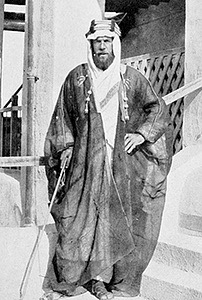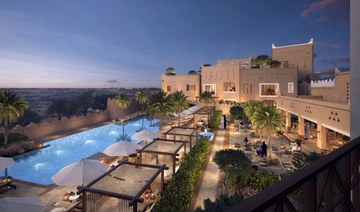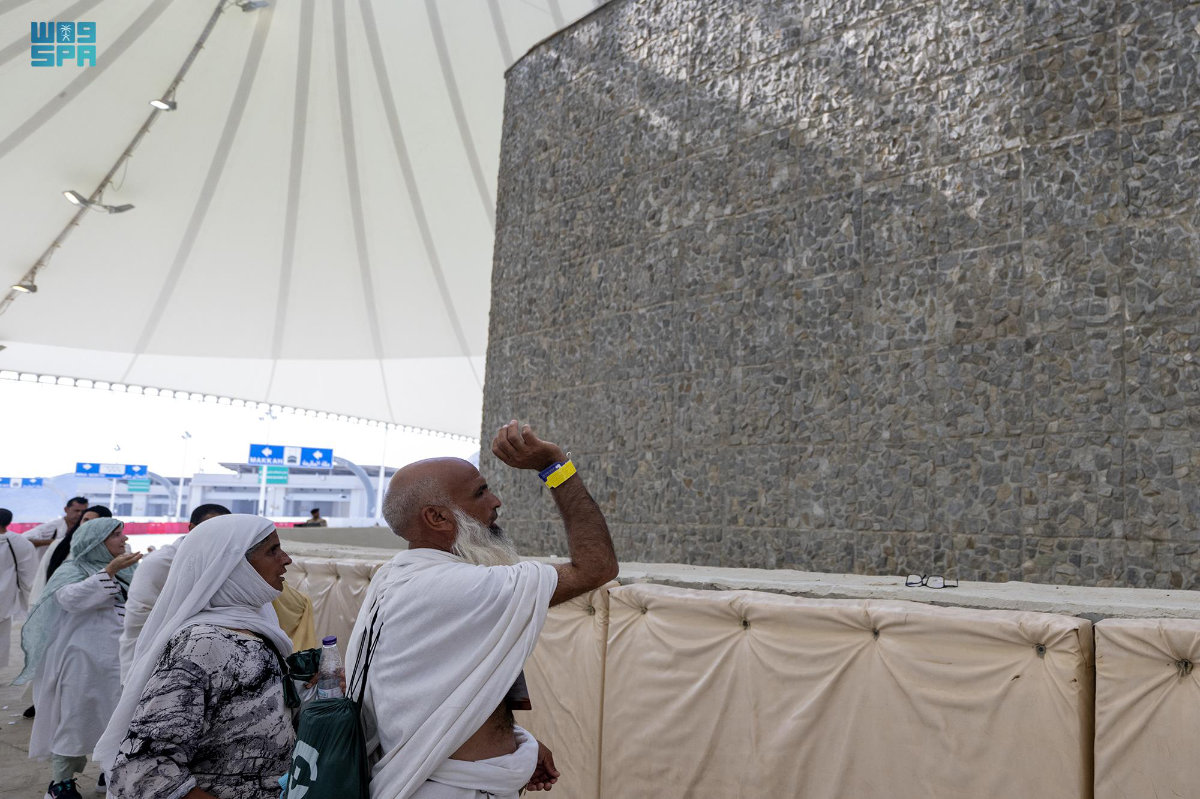DIRIYAH: The Heart of Arabia expedition is set to launch an initiative, the Philby Arabia Fund, in collaboration with the Saudi British Society, that would provide an award to a researcher, creative or historian seeking to study and promote further understanding of the Kingdom.
The award honors British Arabist, explorer and writer Harry St. John Bridger Philby, who converted to Islam and took the name Abdullah. He undertook an information-gathering expedition across what is now modern-day Saudi Arabia in 1917.
The two-part, 1,300-km-journey is now being memorialized by the Heart of Arabia initiative, which aims to loosely follow Philby’s path.

A portrait of British explorer and documentrian Harry St. John Philby wearing traditional Saudi clothing.
The fund seeks to extend the legacy of the traveler and is being overseen by the Saudi British Society. It was established by Executive Director of Outward Bound Oman Mark Evans, chairman of the society, former UK Ambassador to the Kingdom Sir William Patey, and Philby’s direct descendant Mike Engelbach.
“It was fantastic that we got the support and that the Saudi British Society was so quick to get onto it,” Engelbach said.
The society is a nonprofit dedicated to perpetuating the long-standing relations between the two kingdoms, and has been a key supporter of the Heart of Arabia expedition, which was named after Philby’s book published in 1922.
FASTFACTS
• The current Philby-inspired expedition completed its first leg in November in Riyadh, with 2,500 downloads of its podcast in 52 countries and considerable site traffic.
• The group will begin the next leg of the journey to the edge of the Western coast on Jan. 16. The team includes Evans alongside Swiss photographer Ana-Maria Pavalache, regional expert Alan Morrissey, and Philby’s granddaughter, explorer Reem Philby.
• The fund encourages study of all aspects of Saudi geography, topography, geology, wildlife and culture, as Philby did, or a new field entirely.
“(The fund) is there to support anyone who’s doing something that adds to our knowledge and understanding of the Kingdom of Saudi Arabia, especially things that are connected to fill these spheres of interest,” Evans, the leader of the expedition, told Arab News.
Open to all types of studies
The fund encourages study of all aspects of Saudi geography, topography, geology, wildlife and culture, as Philby did, or a new field entirely.
The goal of the award is two-fold: The first is to spotlight the unique individual, Abdullah Philby, who played a crucial part in the evolution of the Kingdom.
The second is to challenge some of the stereotypes that foreigners have of Saudi Arabia.
While the fund has yet to outline key roles and logistics, applicants will have to apply with an overview of their objectives and budgets. The society’s board of trustees will choose a shortlist and then a winner.
The winner will be required to provide a report of the field research, with digital photos to support findings and outcomes.
“I was lucky enough to live in Riyadh in the 1990s for four years. So I know how beautiful Saudi Arabia is and how hospitable the people are. People in the West tend to be driven by headlines and don’t really look beyond (them),” Evans said.
The fund will not only highlight the diversity and culture within the region, but also the nuances of a changing region since Philby’s journey, in an effort to inspire youth globally.
Philby’s aims
“Philby was incredibly good at traveling or journeying with purpose. He didn’t do it for him. It wasn’t just a race to get from A to B, to be the first person to cross this or do that,” Evans explained.
The explorer made regular visits to London, where he presented his findings to the Royal Geographical Society. As a meticulous documentarian, he would relay details of his journey which supported the early mapping of central Arabia, making him a key figure in archiving the region’s history.
“Everything he saw in the field, everything he heard, smelled, touched; he was using his senses all the time to describe a landscape that no one else outside of Arabia had ever seen,” Evans said.
The current Philby-inspired expedition completed its first leg in November in Riyadh, with 2,500 downloads of its podcast in 52 countries and considerable site traffic.
“The plan was to build that platform of interest on leg one so that we could really go at leg two to use that platform to start to raise awareness of the Philby Arabia Fund, in the hope that we can get one or two individuals to make some serious donations to establish that fund,” Evans said.
The group will begin the next leg of the journey to the edge of the Western coast on Jan. 16. The team includes Evans alongside Swiss photographer Ana-Maria Pavalache, regional expert Alan Morrissey, and Philby’s granddaughter, explorer Reem Philby. They will be seen off by Princess Anne.
“There really is nothing at the moment that I’m aware of to fund research or projects like our Heart of Arabia, that adds to our understanding of deserts, but also, in particular, Saudi Arabia.
“This (fund) is something quite unique that people can apply for with the ultimate aim of doing what Philby was very good at, which was enlightening us all and helping us understand more about this beautiful country,” Evans said.
Ibn Saud’s friendship
The great legacy of Philby began 105 years ago, as he trekked through the Empty Quarter on a political mission in 1917 to meet the ruling head of the region at the time, Ibn Saud, the results of which earned him the Royal Geographical Society Founder’s Medal.
The explorer was captivated by the charisma and persona of the ruler, and the same intrigue was reciprocated, forming a friendship that lasted 36 years. Philby often attended council meetings, conducted business, and documented Riyadh. Even a century ago, the bond between Saudi and Britain stood strong.
“He saw things in black and white, and that was where he and Ibn Saud were a good match, because Ibn Saud also could see the shades of gray,” Engelbach said.
Philby was characterized as “one of its most distinguished explorers” by Laurence Kirwan, the director of the Royal Geographical Society, in 1960 upon his death.
His strength shone brightest during the long and often lonely desert journeys, focusing his skills and knowledge on harvesting the cultural treasures held within the region that contributed to unprecedented findings about Arabia and the third Saudi Kingdom.
“He was never happier than out in the desert, with as he puts it, his Arabs, guides, and his retinue,” Engelbach said.
His later years consisted of conversing with younger people about his escapades and the importance of his work, quite often sharing his thoughts and experiences with the Arab world.
“He preferred the company of young people most … He was staunchly pro-Arab … Everything was driven by the idea that the Arab countries should have the right to self-determination. He was just taken aback by the beauty of the Arabian landscape,” Engelbach said.































